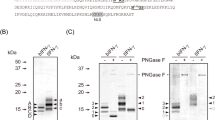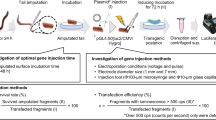Abstract
Microorganisms are generally used for mass production of foreign gene products, but multicellular organisms such as plants have been proposed as an economical alternative. The silkworm may be useful in this context as it can be cultured easily and at low cost. We have therefore developed a virus vector to introduce foreign genes, for example, the gene for human α-Interferon (IFN-α), into silkworms. We used the baculovirus Bombyx mori nuclear polyhedrosis virus (BmNPV) which has a large (>100 kilobases, kb) double-stranded circular DNA genome within its rod-shaped capsid. Baculoviruses have been used previously as vectors for expression of β-Interferon and β-galactosidase in established cell lines1,2. Although BmNPV has not been used previously as an expression vector, it has an advantage over the baculovirus Autographa californica NPV in that it has a narrower host range and will not grow in wild insect pests in the field. In the present study, the polyhedrin gene encoding the major inclusion body protein of BmNPV was identified by hybridization with complementary DNA and cloned in a plasmid. For insertion of foreign genes, we constructed a recombinant plasmid carrying a polylinker linked to the promoter of the polyhedrin gene, and inserted the IFN-α gene into this plasmid. The resulting plasmid and the BmNPV genomic DNA were co-transfected into BM-N cells, and stable recombinant viruses isolated by plaque assay on BM-N cells. The recombinant virus replicated in silkworm larvae, which synthesized as much as 5×107 units (∼50 µg) of Interferon in their haemolymph.
This is a preview of subscription content, access via your institution
Access options
Subscribe to this journal
Receive 51 print issues and online access
$199.00 per year
only $3.90 per issue
Buy this article
- Purchase on Springer Link
- Instant access to full article PDF
Prices may be subject to local taxes which are calculated during checkout
Similar content being viewed by others
References
Smith, G. E., Summers, M. D. & Fraser, M. J. Molec. cell. Biol. 3, 2156–2165 (1983).
Pennock, G. D., Shoemaker, C. & Miller, L. K. Molec. cell. Biol. 4, 399–406 (1984).
Maeda, S. J. seric. Sci., Tokyo 53, 547–548 (1984).
Sanger, F., Nicklen, S. & Baer, R. Proc. natn. Acad. Sci. U.S.A. 74, 5463–5467 (1977).
Guo, L.-H. & Wu, R. Meth. Enzym. 100, 60–96 (1983).
Serebryani, S. B. et al. J. Invertebr. Path. 30, 442–443 (1977).
Ullrich, A., Gray, A., Goeddel, D. V. & Dull, T. J. J. molec. Biol. 156, 467–486 (1982).
Fukunaga, R., Sokawa, Y. & Nagata, S. Proc. natn. Acad. Sci. U.S.A. 81, 5086–5090 (1984).
Tojo, S., Betchaku, T., Ziccardi, V. J. & Wyatt, G. R. J. Cell Biol. 78, 823–838 (1978).
Familletti, P. C., Rubinstein, S. & Pestka, S. Meth. Enzym. 78, 387–394 (1981).
Author information
Authors and Affiliations
Rights and permissions
About this article
Cite this article
Maeda, S., Kawai, T., Obinata, M. et al. Production of human α-interferon in silkworm using a baculovirus vector. Nature 315, 592–594 (1985). https://doi.org/10.1038/315592a0
Received:
Accepted:
Issue Date:
DOI: https://doi.org/10.1038/315592a0
This article is cited by
-
Insights into the quality of recombinant proteins produced by two different Bombyx mori expression systems
Scientific Reports (2022)
-
A database of crop pest cell lines
In Vitro Cellular & Developmental Biology - Animal (2022)
-
Application of biotechnology in sericulture: Progress, scope and prospect
The Nucleus (2022)
-
H3K4me3 histone modification in baculovirus-infected silkworm cells
Virus Genes (2021)
-
Whole-genome sequencing and comparative transcriptome analysis of Bombyx mori nucleopolyhedrovirus La strain
Virus Genes (2020)
Comments
By submitting a comment you agree to abide by our Terms and Community Guidelines. If you find something abusive or that does not comply with our terms or guidelines please flag it as inappropriate.



